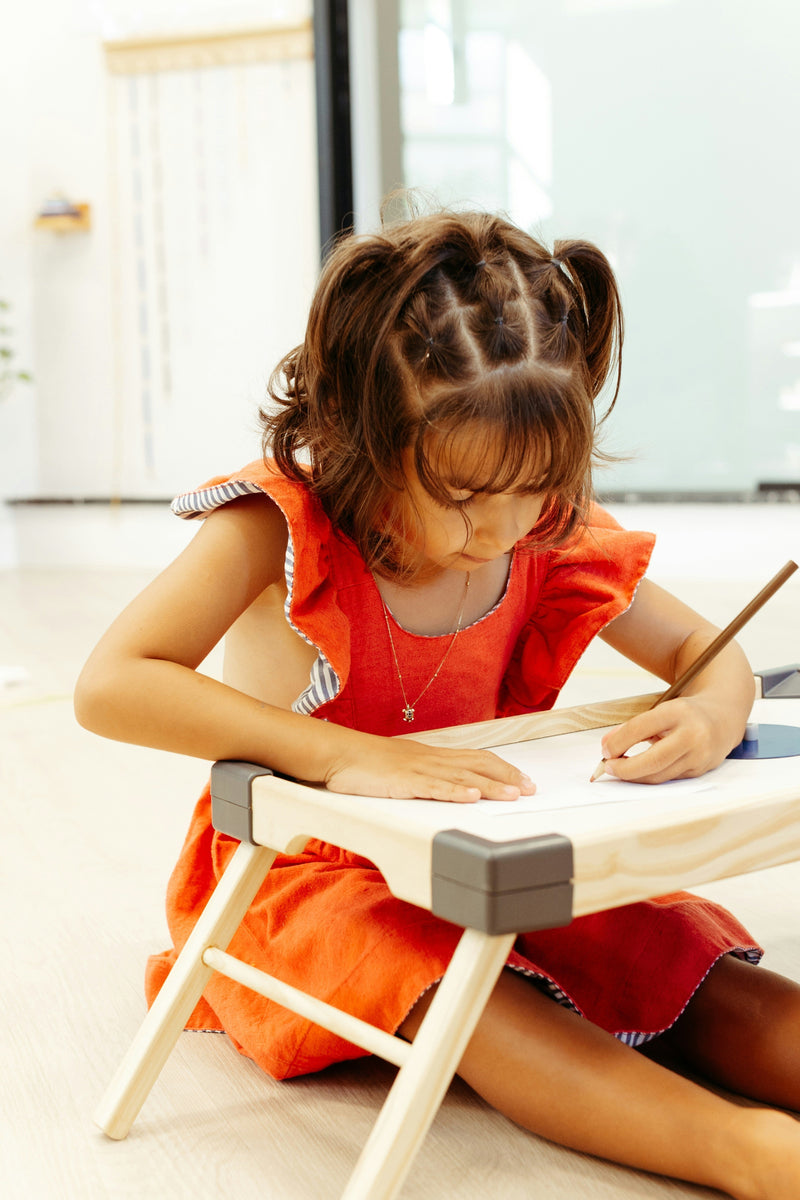
Journaling for Little Minds: How Writing Unlocks a World of Growth for Young Learners 📝✨
Have you ever watched a child's face light up when they proudly show you what they've created? That simple moment of connection—sharing thoughts transformed into words or pictures—holds more developmental power than we might realize. In classrooms and homes across the country, a quiet revolution is happening as more educators and parents discover the remarkable benefits of regular journaling for young children. It's not just about recording daily events; it's about nurturing minds, hearts, and skills that will serve children for a lifetime. 🌱📔
More Than Words: The Hidden Benefits of Journaling for Young Minds 🧠💫
When children put pen to paper (or fingers to keyboard), they're developing far more than just writing skills. Research consistently shows that regular journaling offers children a treasure trove of benefits:
- They develop stronger literacy skills that transfer to all academic areas 📚🔤
- They build critical thinking abilities through reflection and organization of thoughts 🤔💭
- They process emotions more effectively, leading to better self-regulation 😊😔
- They grow in self-awareness and identity development 🪞❤️
- They exercise creativity and problem-solving in a low-pressure environment 🎨🧩
The Confident Mindset Journal is specifically designed to nurture these skills through guided prompts that encourage children to recognize their strengths, process challenges, and build resilience—all while strengthening their writing abilities. 📔✨
What Makes Journal Writing Different from Other School Writing 📝📓
As an elementary school teacher once told me, "There's a world of difference between assigning a report and inviting journal writing." That distinction matters enormously:
Traditional School Writing:
- Often focuses primarily on conventions and correctness ✅
- Usually has a single "right answer" or approach 🎯
- Typically evaluated with grades or corrections 🔍
- Generally meant for teacher consumption 👨🏫
Journal Writing:
- Emphasizes authentic expression and thinking 💭
- Welcomes multiple perspectives and approaches 🔄
- Creates a safe space for experimentation and growth 🌱
- Connects writing to personal meaning and relevance ❤️
The Curiosity Mindset Journal harnesses children's natural inquisitiveness, turning their questions into powerful learning opportunities and building critical thinking skills through guided reflection. 🔍✨
The Research Behind the Magic: Why Journaling Works 📊🔬
Education researchers have been studying the impact of journal writing for decades, and the findings are compelling:
- Students who engage in regular reflective writing show significant improvements in reading comprehension scores 📈
- Journal writing creates stronger neural connections between reading and writing centers in the brain 🧠
- Children who journal regularly demonstrate more sophisticated vocabulary and sentence structures 🔤
- Emotional processing through journaling is linked to reduced anxiety and improved focus in the classroom 😌
- Regular writers show greater metacognitive awareness—they know what they know and what they don't know 💡
As one researcher put it, "When children journal, they're not just recording thoughts—they're actually creating new thought patterns and abilities." The structured prompts in tools like the Confident Mindset Journal help guide this powerful cognitive development. 📝🧠
The Social-Emotional Powerhouse: Journaling for Whole-Child Development ❤️🧠
In an era when educators and parents increasingly recognize the importance of social-emotional learning, journaling stands out as one of the most effective tools available:
- It provides a private space for children to process complex feelings 💭❤️
- It builds self-awareness through guided reflection on experiences 🪞✨
- It develops empathy when journal prompts invite perspective-taking 👫💕
- It strengthens emotional vocabulary beyond basic "happy/sad" descriptions 🔤😊
- It creates a record of growth that builds confidence and resilience 📈💪
The Kindness Mindset Journal specifically nurtures these emotional intelligence skills through prompts that help children understand themselves and connect compassionately with others. 📔💕
From Reluctance to Renaissance: How Schools Are Transforming Through Journal Practices 🏫✍️
Educators across the country are finding creative ways to incorporate journaling into already-packed school days:
Morning Meeting Journals 🌅
Many classrooms now begin with brief (5-10 minute) journaling periods that set a reflective tone for the day and provide a gentle transition into learning.
Cross-Curricular Connections 🔄
Science teachers ask students to journal predictions before experiments. History teachers invite reflections on historical figures' decisions. Math teachers have students explain problem-solving strategies in writing.
Emotional Check-Ins 🧭
When classroom conflicts arise, many teachers now incorporate structured journaling before discussion, helping students identify feelings and needs.
Parent-Child Communication Bridges 🌉
Some innovative schools use journals as communication tools, with parents and teachers both responding to student entries, creating meaningful dialogue.
Celebration of Growth 🎉
End-of-year journal review activities help students recognize their academic and personal development over time.
The My Furry Soulmates series provides engaging stories that can spark meaningful journal reflections in classroom settings, connecting literacy with social-emotional learning. 📚🦊
Making Room for Journaling: Practical Classroom Implementation 🗓️📝
Let's be real—teachers already juggle countless priorities within limited instructional time. Here's how successful educators are making journaling work in busy classrooms:
Start Small but Consistent 🕒
Even 5-10 minutes of regular journaling yields significant benefits. One second-grade teacher shared, "We journal for just eight minutes after lunch three days a week, but those minutes have transformed our classroom culture."
Use Structured Prompts 🧩
Quality prompts make journaling more accessible for reluctant writers. The Confident Mindset Journal provides developmentally appropriate prompts that scaffold children's thinking while building writing skills.
Create Meaningful Routines 🔄
Successful journal implementations become part of the classroom rhythm. "Thursday Thought Journal" or "Monday Mindset Reflection" creates anticipated structure.
Balance Freedom and Guidance 🏗️
Many teachers alternate between open-ended journal time and more directed prompts, providing both structure and creative expression opportunities.
Connect to Standards Creatively 📋
Savvy educators recognize how journaling naturally addresses numerous academic standards across subjects, making it easier to justify the time investment.
From School to Home: Creating Journaling Partnerships 🏫🏠
The most powerful journaling practices happen when schools and families work together:
- Schools can host "family journal nights" where parents learn about journaling benefits 👨👩👧👦
- Teachers can send home optional journal prompts that extend classroom discussions 📝
- Families can share appropriate journal entries during parent-teacher conferences to provide deeper insights into the child's thinking 🗣️
- Home journaling using tools like the Confident Mindset Journal can reinforce school-based writing in a different context 🏠
As one parent shared, "The journal prompts my daughter brings home have sparked the most amazing dinner conversations. We're connecting on a whole new level." 💬❤️
Diverse Journaling Approaches for Diverse Learners 🌈📔
Effective journaling practices recognize and accommodate different learning styles and needs:
For Emerging Writers ✏️
- Combination of drawing and writing
- Dictation options for complex thoughts
- Word banks and sentence starters
For Multilingual Learners 🌍
- Journaling in home language, English, or a combination
- Visual journaling with labeled illustrations
- Dual-language journal prompts
For Children with Learning Differences 🧩
- Audio journaling options
- Graphic organizers and structured templates
- Choice in response format (lists, webs, paragraphs)
The My Furry Soulmates series features diverse animal characters facing different challenges, providing inclusive representation that helps all children see themselves in stories that spark journal reflections. 📚🦊
Getting Started: First Steps for Educators and Parents 👣🌱
Ready to harness the power of journaling for the children in your life? Start with these approachable steps:
For Teachers:
- Introduce journaling as an exciting tool for self-discovery, not just another writing assignment 🎁
- Begin with highly engaging prompts that connect to children's lives and interests 🔗
- Model your own journaling process, sharing appropriate examples 👩🏫
- Create clear expectations about privacy and sharing (what must be shared, what may be kept private) 🔒
- Celebrate growth in thinking and expression, not just writing mechanics 🎉
For Parents:
- Make journaling materials special but accessible 📔
- Establish a regular time for journaling that works with family routines ⏰
- Use guided journals like the Confident Mindset Journal that provide age-appropriate structure 📝
- Share your own reflective practices in age-appropriate ways 👨👩👧👦
- Focus on the joy of expression rather than perfection 💫
Overcoming Common Hurdles to Successful Journaling 🚧🚀
Even with all these benefits, implementing journaling practices can face challenges. Here's how educators and parents successfully navigate common obstacles:
"I Don't Know What to Write" 🤔
- Provide visual inspiration (images, objects, short videos)
- Offer choice between 2-3 specific prompts
- Start with sentence stems ("I wonder..." "I notice..." "I feel...")
Resistance to Writing ✋
- Begin with drawing journals that gradually incorporate words
- Try "talk before write" strategies where ideas are verbalized first
- Use the engaging stories in the My Furry Soulmates series as springboards for reflection
Concern About Skills and Conventions 📝
- Establish journals as "growth zones" where perfect spelling and grammar aren't required
- Focus feedback on ideas and thinking, not mechanics
- Set aside separate time for skill-specific writing instruction
Time Constraints ⏰
- Look for natural transitions in the day for brief journaling
- Connect journaling directly to content learning objectives
- Remember that even 5 minutes of quality reflection yields benefits
The Long View: Journaling as Life Preparation 🔭🌟
When we invite children into journaling practices, we're doing far more than building academic skills—we're helping them develop life tools they'll use for decades to come:
- Self-awareness: In a world of constant external stimulation, the ability to understand one's own thoughts and feelings becomes increasingly valuable 🧠❤️
- Communication skills: Tomorrow's leaders need to articulate ideas clearly and persuasively across multiple formats 🗣️📝
- Critical thinking: The future workforce requires people who can analyze, synthesize, and evaluate information independently 🤔💡
- Emotional regulation: Success in relationships and careers depends heavily on managing emotions effectively 😌🧘♀️
- Reflection habits: Lifelong learning requires the ability to process experiences and extract meaningful insights 🔍🌱
By introducing tools like the Confident Mindset Journal, Curiosity Mindset Journal, and Kindness Mindset Journal during childhood, we help establish these essential habits during their most formative years. 📚🧱
Join Our Journaling Conversation! 💬❤️
How have you incorporated journaling practices in your classroom or home? What benefits have you observed in the children you work with? Share your experiences in the comments below!
Remember: When we give children the gift of journaling, we're not just teaching them to write—we're teaching them to think, feel, connect, and grow. In a world of standardized testing and academic pressure, these tools for self-discovery and authentic expression may be among the most valuable skills we can nurture. The journal pages they fill today become the foundation for the stories they'll write with their lives tomorrow. ✨🌟



0 comments